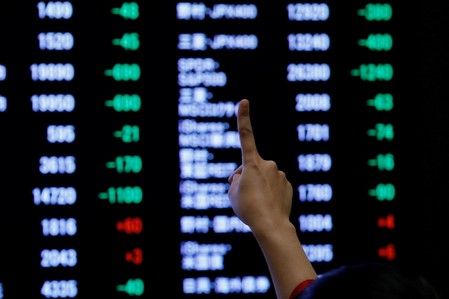
European shares followed Asian stocks higher on Monday after the United States shelved plans to impose tariffs on Mexico and as investors anticipated lower U.S. interest rates when the Federal Reserve meets next week on the back of poor jobs data.
Investors had fretted that opening up another trade conflict, while still battling with China, could push the United States and other major economies into recession. The Mexican peso rallied more than 2% on Monday.
But in China, the yuan slipped to its weakest this year after the country’s imports fell the most in nearly three years and as talks to end the Sino-U.S. dispute remained deadlocked.
The pan-European STOXX 600 gained 0.3% in early trade, with Britain’s FTSE 100 up 0.6%, while S&P500 mini futures were up 0.3% after rising as much as 0.8%.
The 10-year U.S. Treasuries yield was at 2.1345 percent, after hitting a 21-month low of 2.053 percent on Friday on soft U.S. jobs data.
In Asia, Tokyo’s Nikkei closed up 1.2%, while MSCI’s index of Asia-Pacific shares outside Japan rose as much as 1%.
“Markets are blowing small celebratory bubbles,” said Deutsche Bank strategist Jim Reid.
“There will be relief that the [Mexican] tariffs have been avoided and perhaps some might believe it shows Trump’s propensity to strike deals after brinkmanship. As such there may be those thinking that a similar thing might happen with the China trade situation.”
CARS MOVE AHEAD
The European auto sector was boosted by signs that Fiat Chrysler Automobiles NV and Renault SA were looking for ways to revive their collapsed merger plan and secure the approval of Nissan Motor Co. Fiat Chrysler jumped 3%, while Renault’s shares were up 1%.
In London, Thomas Cook’s shares rose 20% after a report that Hong Kong-listed Fosun Tourism was in talks to buy its tour operating business as the British group faces breakup after issuing three profit warnings in the past year.
Investors were also digesting Chinese data showing imports in May contracted 8.5% from a year earlier, a much worse than expected outcome that signalled weak domestic consumption.
Exports, however, unexpectedly rose 1.1% last month, though many suspect the uptick is linked to front-loading of shipments by firms to avoid higher U.S. tariffs.
“Mexico is not China and investors will want to see some clear signs of improvement in U.S.-China relations before increasing exposure to risk assets. Before then the market is left focusing on poor Chinese import figures for May…..as speculation builds over whether the PBOC [the People’s Bank of China] allows yuan to trade through 7 per dollar,” said Chris Turner head of FX strategy at ING Bank.
EYES ON THE FED
In the United States, expectations the Federal Reserve will cut rates kept the dollar on the defensive after a weak jobs report from the U.S. Labor Department.
Nonfarm payrolls increased by 75,000 jobs last month, much smaller than the 185,000 additions estimated by economists in a Reuters poll.
Fed funds rate futures prices, down on Monday after the Mexico deal, were still pricing in more than two 25-basis point rate cuts by the end of this year, with one almost fully priced in by July.
The Federal Reserve’s next policy meeting is set for next week, on June 18-19.
The euro was down almost 0.3% against the dollar at $1.1301 EUR= near a 2-1/2-month high of $1.1347 touched on Friday.
Euro zone government bond yields remained close to all-time lows. Core bond yields in the bloc were still at all-time lows, despite the two basis point move higher in the German bund in early trade to -0.24%, as expectations of easier monetary policy fuel bond buying.
The euro was down almost 0.3% against the dollar at $1.1301 EUR= near a 2-1/2-month high of $1.1347 touched on Friday.
The onshore yuan fell as much as 0.35% to as low as 6.9366 per dollar, its weakest since early December, when U.S. President Donald Trump last met Chinese President Xi Jinping for trade talks.
Gold slipped almost 1%, having hit a 14-month high of $1,348.1 per ounce on Friday, near a major resistance around $1,350.
Many investors are still clinging to hopes that Trump will meet his Chinese counterpart Xi on the sidelines of the Group of 20 leaders’ meeting late this month to seek a compromise on trade and other economic issues.
Oil prices rose on Monday after Saudi Arabia said producer club OPEC and Russia should restrict supplies to current levels, with front-month Brent crude futures at $63.61, 0.5%, above Friday’s close.
